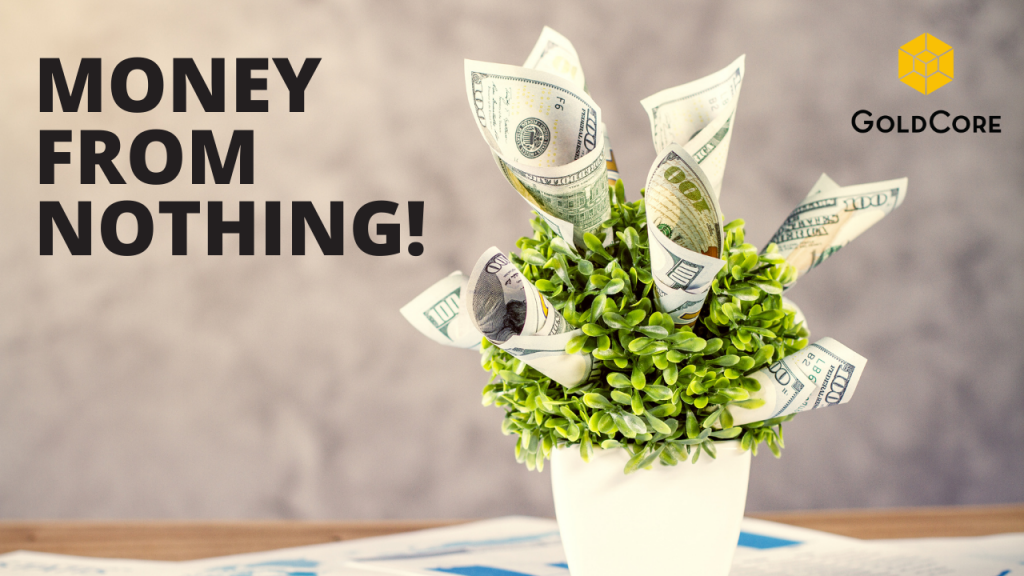
Central bank meetings over this week (Bank of Canada and European Central Bank) and next week (Bank of England and Federal Reserve) will almost certainly be centered around what approach the central banks should take regarding rising government bond yields.
Central banks can choose to continue more of the same, which is to remind markets that central bank policy rates are likely to stay low for the foreseeable future, and hope that longer dated bonds don’t get too high. A second option is that central banks can jawbone yields back down by discussing the possibility of more asset purchases. A third option is central banks could actually purchase additional assets. In particular they could purchase longer dated government bonds to force yields back down.
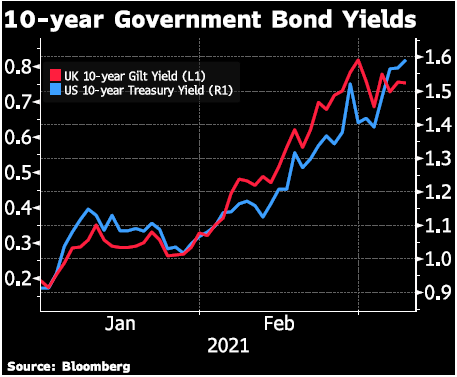
This all becomes quite precarious for central banks, as they have already added massive amounts to their balance sheets. Is there such a thing as too much? And if so, how much is too much? Furthermore, attention has turned to a post-Covid-19 world. The increase in money supplies these asset purchases have generated is coming into focus, hence the rising bond yields.
That was then, this is now!
However, there is a key difference between the quantitative easing of the Great Financial Crisis of 2008-10 and now. This time a large portion of this round of quantitative easing flowed through to consumers, not just the banks.
Below we present a refresher of how the money multiplier works. The start of which comes from central bank asset purchases. This then waterfalls into the monetary base, then money supply. After that then on to the velocity of money and tie it all together on how this leads to inflation.
How Central Banks Creates Money
It starts with a central bank deciding to implement a quantitative easing program by purchasing assets (or through loans). The central bank then goes into the market and makes purchases and credits the counter party dealer (consumer bank) with ‘electronic’ money. The counter party can choose to either leave the money at the central bank as a reserve or take the money out of the central bank and use it to make loans to businesses and households, or it can use the money to purchase other assets. The money created by the central bank becomes a liability on the central bank’s balance sheet as either a reserve or currency in circulation.
These reserves and currency then become components of the monetary base, also referred to as high-powered money. It is the ‘base’ of the monetary system that consumer banks can lend from.
Watch Max Keiser’s Interview on GoldCore TV
Max Keiser: Why is Gold in Bitcoin’s shadow
Generally, central banks require each bank to hold a percentage of deposits as reserves of approximately 10%. Using a 10% reserve requirement for example, a bank can lend out the other 90% of the newly created money. Once that transaction is complete then the bank can lend out 90% of the new transaction and so on. This process is called the multiplier effect and the result of this process is a country’s money supply.
But That’s Not Fair!
Proponents of Bitcoin cite this money creation and multiplier as major reasons central banking is unfair. Why must central bank created money pass through the hands of giant banks before reaching consumers?
How is it fair banks are considered solvent with only 10% liquid backing but no one else enjoys that privilege? Just as Gamestop trading is a story about regular people versus the ‘suits’ who can short sell endlessly: bitcoiners and gold investors both dream of a more egalitarian financial system.
Using the United States as an example, the multiplier effect fell drastically in 2008-09 due to the increase in the monetary base but hasn’t changed much during this last massive round of QE. This is because a much larger portion of the monetary base is now part of money supply as banks are choosing to lend more of this money to consumers and purchase other assets than in 2008-10. (There are many measures of money supply, but a common measure is M2 which includes: currency and coins held by the public, checkable deposits, savings deposits, and retail money funds).
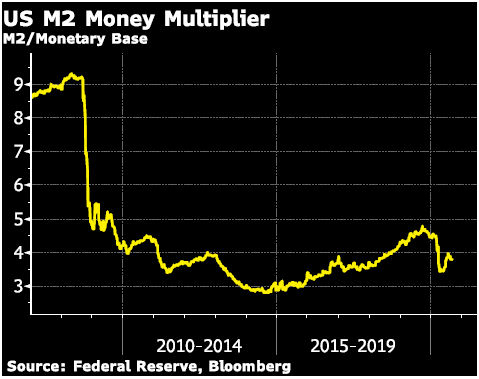
This increased activity by banks has led to a more than 25% percent increase in the US M2 money supply. The increase in 2008-09 was around 10%.
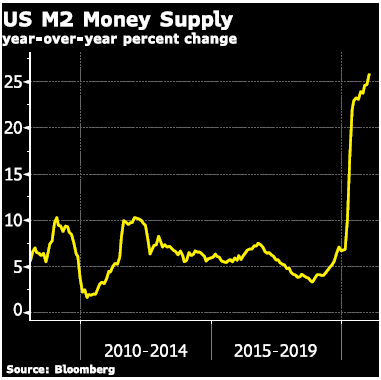
The US is not alone in rapidly increasing money supplies. The M2 money supply in the Eurozone has increased by 12%, Canada’s by 18%, and the UK’s by 20%.
What is the Velocity of Money?
The last component to show is the velocity of money. This is defined as “the rate at which money is exchanged in the economy” . Another way to think of it is, how fast is money circulating in the economy. This is the component that has continued to decline during the current round of pandemic quantitative easing. However, this is likely to change in a post-pandemic world with pent-up demand being unleashed.
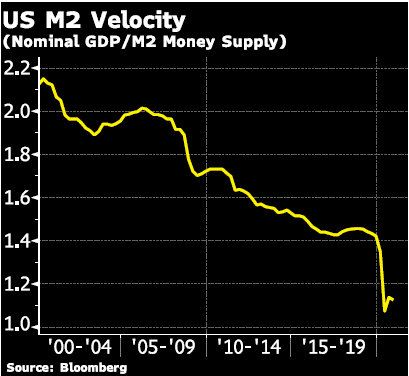
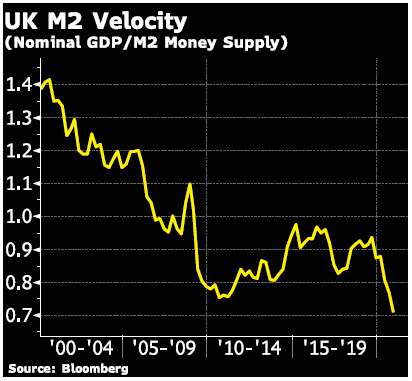
A rule of thumb definition for inflation is too much money chasing too few goods. The too much money is the creation of central banks, and the end of the pandemic is likely to be the incubator for the chasing and government protectionist policy could add fuel to the too few goods.
Yield Curve Control is Coming!
Going back to central bank decisions over this week and next week and the question at hand of, what will central banks do about rising government bond yields? Well, if not at this month’s meeting than at meetings in coming months financial repression in some form of lowering these yields is very likely, because rising government yields strain government finances and choke economic growth – exact opposite of central bank objectives. This could prove to be one catalyst over the coming months that will help propel gold and silver prices past previous highs!
Watch Jim Rogers on GoldCore TV
Jim Rogers – Why I’m Buying More Gold & Silver in 2021
GOLD PRICES (USD, GBP & EUR – AM/ PM LBMA Fix)
10-03-2021 1711.50 1716.20 1231.94 1233.60 1438.86 1440.92
09-03-2021 1702.85 1716.90 1228.10 1233.25 1430.73 1442.20
08-03-2021 1694.45 1687.05 1224.58 1220.07 1427.07 1420.33
05-03-2021 1696.05 1696.25 1228.96 1227.75 1421.12 1423.83
04-03-2021 1710.05 1712.10 1227.47 1224.49 1420.20 1422.07
03-03-2021 1727.05 1711.40 1235.53 1226.73 1428.27 1419.09
02-03-2021 1728.50 1723.85 1245.21 1237.38 1437.94 1431.66
01-03-2021 1746.95 1734.15 1252.21 1244.95 1450.67 1439.86
26-02-2021 1765.10 1742.85 1268.05 1250.67 1455.85 1438.20
Buy gold coins and bars and store them in the safest vaults in Zurich, Switzerland with GoldCore.
Learn why Switzerland remains a safe-haven jurisdiction for owning precious metals. Access Our Most Popular Guide, the Essential Guide to Storing Gold in Switzerland here


